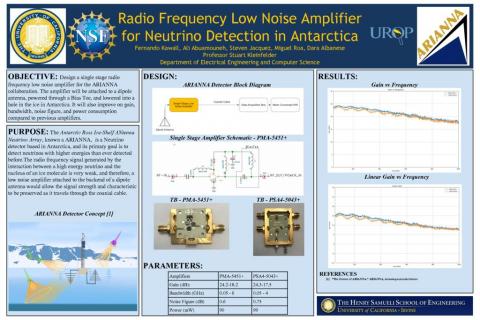RF Low Noise Amplifier for Neutrino Detection in Antarctica
Goal
The Goal of our project is to design a single stage Radio Frequency Amplifier for the ARIANNA Collaboration. The amplifier will be attached to the bachend of an antenna and lowered into a hole in Antartica, alloweing the signal strength and characteristic to be preserved as it travels through a coaxial cable to the data acquisition box.
Purpose
The Antartic Ross Ice-shelf ANtenna Neutrino Array, known as ARIANNA, is a International collaboration with a goal of detecting High Energy Neutrino in Antarctica. High Energy Neutrinos bombard the earth everyday, and in fact, millions of them are passing through you right now. These Neutrinos have very interesting and important properties which allowed physicist to create a new kind of telescope and exploit a new kind of Astronomy.
First, neutrinos are chargeless like photons, which means they are not going to be bent up as they travel through the galaxy by magnetic fields [1]. Magnetic fields are everywhere, and these magnetic fields will cause particles to change their directions, which is very bad if we want to look back and see what made the particle to begin with. Second, neutrinos are also stable, which means once neutrinos are made they will stay a neutrino forever and won’t decay into something else. This is just like a photon, once photos are made they stay like a photon forever. Third, it also has very little mass, and in fact the mass is one of the mysteries of a Neutrino because it’s not zero like a photon, but it’s almost a million times lighter than the next lightest particle we know, the electron [1]. Why does the nature make a particle which has so much less mass than the next most massless particle, yet not zero? We don’t know yet.
Moreover, Neutrinos will pass through just about anything, which means that Neutrinos can pass through a lot of material and very hardly interact. This is the one of the most important properties used for the development of this new kind of telescope since light interacts a lot while Neutrinos don’t [1]. More importantly, this property allows Neutrinos to do different things that photons can’t do. For example, if they are created through violent explosions like a supernova, which have lots of material around them, photons have problems getting out of those objects. They interact very often and scatter, meaning that photons change from what they were when they were initially created, and by the time they get out, they have different energies and are travelling in different directions. However, Neutrinos can go straight out of these violent explosions or the core of the sun, and therefore, what you see is what is happening right now and allow us to pinpoint the sources of these explosions [1]. All the important properties described above allow physicists to exploit Neutrinos and use them for a new kind of astronomy, but to detect such particle very sophisticated instrumentations are required.
In order to detect them, the ARIANNA (Antarctic Ross Ice-Shelf Antenna Neutrino Array) Collaboration developed a powerful detector based at the South Pole which detects radio pulses emitted by Neutrino interactions with ice, known as the Askaryan effect [2] . Throughout the years, many improvements have been made to the hardware including their RF Amplifier known as the Series 300 (3rd Generation), and a new design would be beneficial in order to improve the amplifiers performance at very low temperatures

